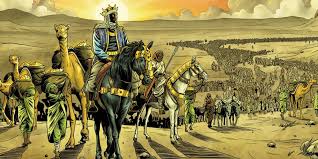During the medieval period, West Africa was the world’s largest source of gold, supplying vast amounts to both Islamic and European economies. The Mali Empire, under rulers like Mansa Musa, controlled the rich goldfields of Bambuk, Bure, and Galam, which made the region the center of the trans-Saharan gold trade. This trade connected West Africa to North Africa, the Middle East, and even Europe, fueling economic growth and influencing global markets.
Mansa Musa’s legendary pilgrimage in 1324 CE showcased Mali’s immense gold wealth, but behind his lavish display was a sophisticated gold trade network that had been supplying gold to the Islamic world and Europe for centuries.

The West African Gold Trade Network
1. Gold Mines of the Mali Empire
The Mali Empire controlled some of the richest gold-producing regions in the world:
✅ Bambuk (along the Senegal River)
✅ Bure (modern-day Guinea and Mali)
✅ Galam (upper Senegal)
These mines produced over half of the world’s gold supply during the medieval period.
2. The Trans-Saharan Trade Routes
West African gold reached international markets through caravan routes crossing the Sahara Desert, linking Mali to North Africa, the Middle East, and Europe. Key trade hubs included:
- Timbuktu – The intellectual and economic heart of Mali.
- Gao – A major commercial center connecting Mali to the Sahara.
- Djenne – A trading hub where gold was exchanged for salt and other goods.
Camels carried gold across the Sahara Desert in massive caravans, where it was traded for salt, textiles, horses, and luxury goods from North Africa and the Mediterranean.
West African Gold in the Islamic World
Islamic economies, especially under the Abbasid Caliphate (750–1258 CE) and later the Mamluk Sultanate (1250–1517 CE), were highly dependent on West African gold.
- The Islamic gold dinar, the most widely used currency in the Muslim world, was largely minted using gold from Mali.
- Gold from Mali was used in mosque decorations, jewelry, and international trade.
- Cairo and Tunis became major gold trading centers, linking Mali’s gold supply to the Middle East and the Mediterranean.
Mansa Musa’s 1324 pilgrimage to Mecca demonstrated how deeply integrated West African gold was in the Islamic financial system.
West African Gold in Europe
By the 14th century, European states were also heavily reliant on West African gold to support their economies.
- Italian city-states like Venice and Genoa traded textiles and weapons for gold from North African markets.
- Portugal and Spain sought direct access to West African gold, eventually leading to the Age of Exploration.
- The Florentine florin (1252 CE) and Venetian ducat (1284 CE) were minted using gold that originated from Mali’s mines.
Mali’s gold wealth played a direct role in reviving gold coinage in Europe, which had nearly disappeared after the fall of the Western Roman Empire.
Conclusion: The Backbone of Global Medieval Trade
The West African gold trade was a key driver of medieval global commerce, supplying Islamic and European economies for centuries. Through trans-Saharan trade routes, gold from Mali reached markets in Cairo, Tunis, Mecca, Venice, and beyond, fueling the growth of Islamic and European financial systems.
Mansa Musa’s famous pilgrimage was a symbol of this economic power, demonstrating how West African gold influenced global markets, set the foundation for European banking and gold coinage, and ultimately led to European exploration of Africa.
